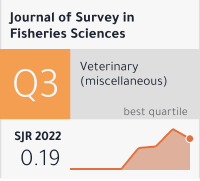Morphological And Molecular Characterization Of Infectious Parasites In Argentine Hake Fish Traded Via Aqaba Port Of Jordan
DOI:
https://doi.org/10.53555/sfs.v10i2.1385Keywords:
Fish, Parasites, Argentine Hake fish, and Myxosporea kudoaAbstract
Various parasites were found in raw fish, and the majority of the scientific literature describes methods for controlling major parasites of concern in the Western World, such as Anisakis parasites (Beldsoe & Oria, 2001; Harvell, 1999). According to archive records, the Argentine Hake fish (Merluccius hubbsi) was the most parasitically infected fish species (81.8%). In addition, Argentine Hake fish was the most imported fish and had the highest infection rate, violating Jordanian standards when compared to other species of fish infected by parasites.
Thirty-three Argentine Hake fish samples were collected from Jordan's Aqaba port. Total bacterial count and culture for Salmonella, Vibrio, Pseudomonas, and E. coli was done. Freshness, Heavy metals, pH, crude protein and lipid, Moisture, Salt, Collagen, Total Volatile Base Nitrogen (TVBN), and Histamine were among the tests performed on those samples. According to the PCR assay, the main parasites isolated from the Argentine Hake fish were Myxosporea kudoa (Kingdom: Animalia,
Phylum: Cnidaria, Class: Myxosporem, Order:Multivalvulida, Family: Kudoidae, Genus: Kudoa). In addition, it was demonstrated that the severity of parasitic infection led to a significant increase in acidity, salt, fat, and water content in the muscle (P>.05).
Furthermore, the severity of parasitic infection led to a significant decrease in protein, collagen, TVP-N, freshness, and bacterial count. Here, parasite density is quantified as the number of parasites per kilogram of fish (>1 parasite/kg fish wt.).
The results of this study suggest that local markets urgently require additional control measures, including the assistance of skilled inspectors. Additionally, it was advised that enough samples be taken from each shipment of fish to allow for a reliable analysis at the specialized labs. Additionally, change the Jordanian standard to "prevent entry of contaminated frozen fish with parasites in the flesh whether it is pathogenic or non-pathogenic," particularly in those parts that deal with frozen fish.









